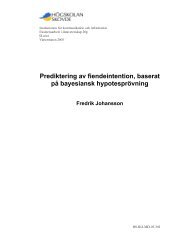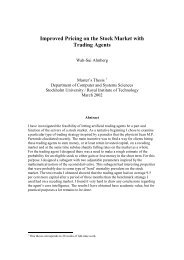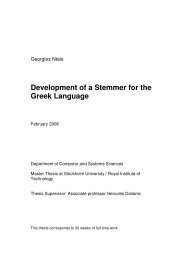Modeling Hydra Behavior Using Methods Founded in Behavior-Based Robotics
Modeling Hydra Behavior Using Methods Founded in ... - SAIS
Modeling Hydra Behavior Using Methods Founded in ... - SAIS
You also want an ePaper? Increase the reach of your titles
YUMPU automatically turns print PDFs into web optimized ePapers that Google loves.
Chapter 8Summary and conclusionsIn this thesis work methods from BBR have been used to model the behavior of a simplebiological organism. Literature studies were conducted concern<strong>in</strong>g suitable model organisms,as well as methods for behavior generation and organization. <strong>Based</strong> on the literaturesurveys, the cnidarian <strong>Hydra</strong> was selected as the model organism for this project, and theCSA was selected as the framework for model<strong>in</strong>g the behavior of <strong>Hydra</strong>. The two ma<strong>in</strong>reasons for choos<strong>in</strong>g <strong>Hydra</strong> as the model organism are the animal’s complexity level, andthe number of measurement data available from prior ethological experiments conductedon the animal. The reasons for choos<strong>in</strong>g the CSA are that it supports implementation ofpriority based behaviors (as is the case with <strong>Hydra</strong>’s behaviors accord<strong>in</strong>g to the literature),as well as allows for model<strong>in</strong>g the reflex properties found <strong>in</strong> <strong>Hydra</strong> such as latency,habituation, and duration of response.The general conclusion of the work conducted <strong>in</strong> this project is that it is possibleto model several of the behavioral properties of <strong>Hydra</strong> us<strong>in</strong>g the CSA as a framework.The modeled latency of <strong>Hydra</strong>’s response to light stimulus, the habituation effect of itsresponse to mechanical stimulus, the duration of a CP and the feed<strong>in</strong>g response, respectively,as well as the variable feed<strong>in</strong>g threshold are consistent with experimental data.Specifically, it was found that a habituation model based on cascaded leaky <strong>in</strong>tegratorscan represent the habituation properties of the animal. Simulations of the overall behaviorof the animal shows that the spatial movement pattern of undisturbed <strong>Hydra</strong>, as wellas the effect of starvation on contraction frequency, agrees with results from experimentsconducted on the physical animal. In order to obta<strong>in</strong> conclusive results concern<strong>in</strong>g theoverall behavior of <strong>Hydra</strong>, however, some improvements rema<strong>in</strong>.Several future contributions would be of <strong>in</strong>terest: Expand<strong>in</strong>g the model to <strong>in</strong>cludethe morphology of <strong>Hydra</strong> would allow for more accurate model<strong>in</strong>g, e.g. of the durationof an LP, as well as the distance of movement, <strong>in</strong> the case of locomotion by means ofsomersault<strong>in</strong>g, as discussed <strong>in</strong> Section 7.2.1. Generation of more test data for validationpurposes would also be of <strong>in</strong>terest. For example, a record<strong>in</strong>g not only of the spatial45





